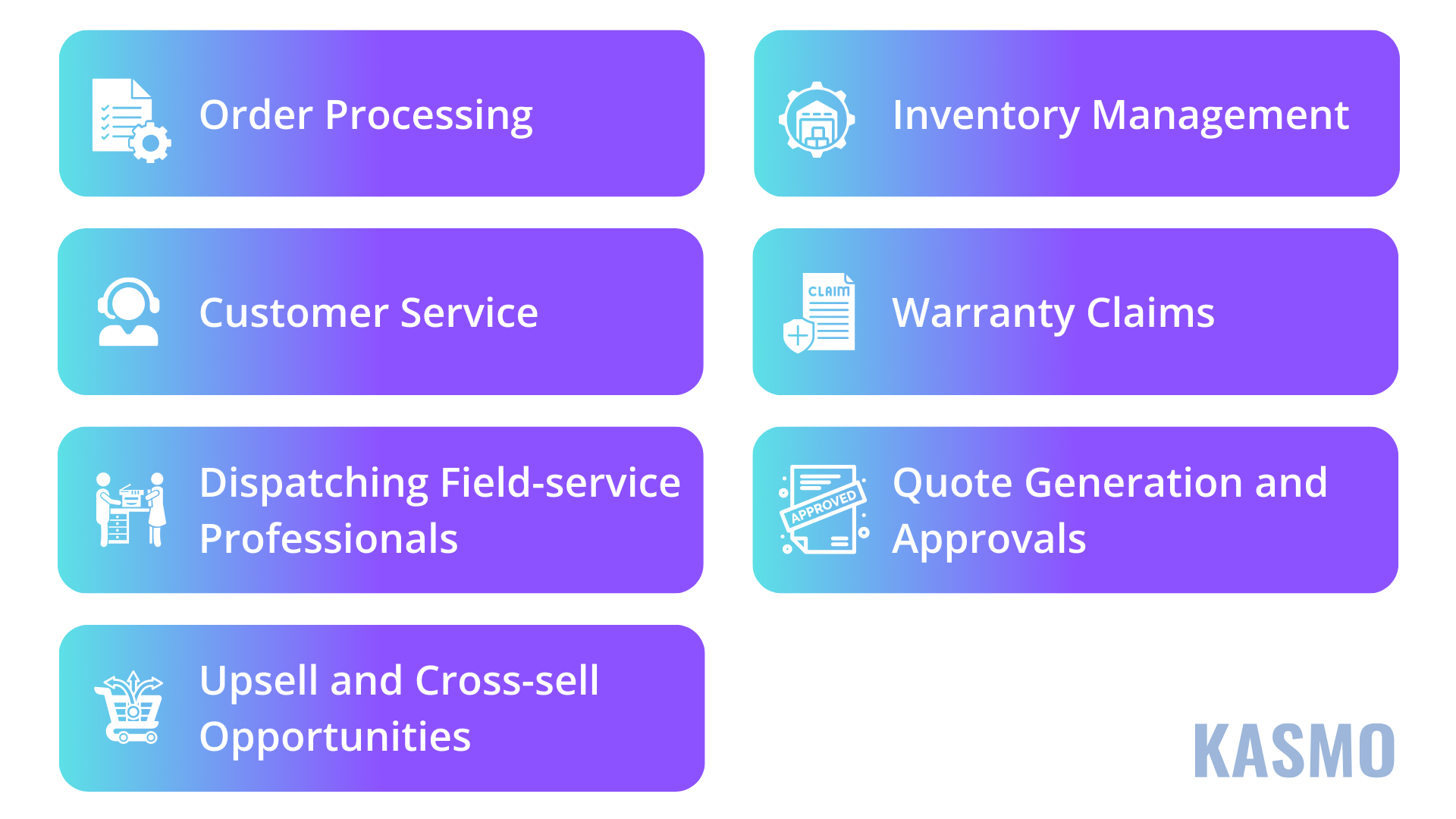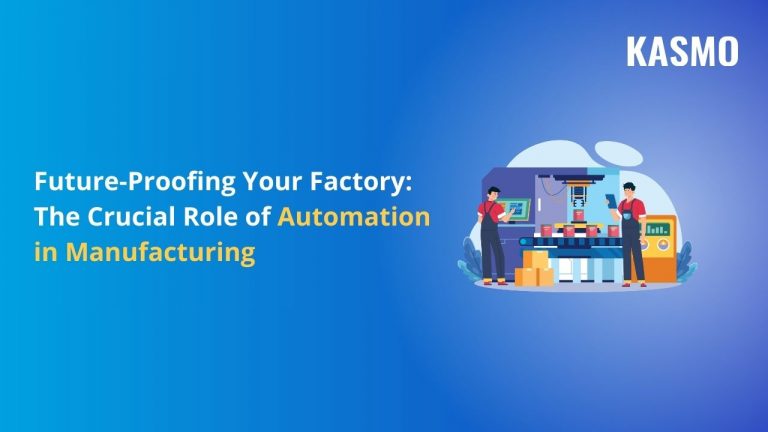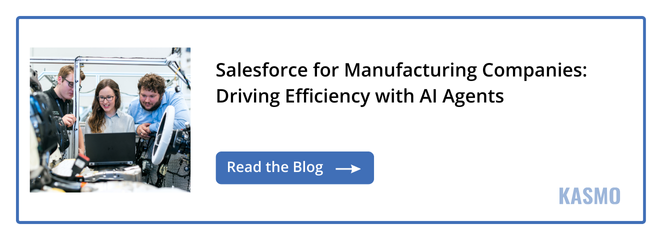Introduction
Robots and AI-powered tools are not the great future anymore – they are the present. Businesses have been leveraging AI and AI-powered tools to automate manual tasks and empower human professionals to focus more on making strategic decisions and creating out-of-the-box solutions for customers. The manufacturing industry is also not a stranger to technological developments and AI. Implementing automation in manufacturing has enabled manufacturers to create optimized and automated workflows that not only help them create innovative products but also enable them to streamline customer service.
Industrial automation solutions have enabled manufacturing companies to manage inventory, warehouse and deliver products on time. Now, customers can talk with AI-powered chatbots and AI agents to get solutions to their queries faster. Self-service portals are also powered by AI agents that empower customers to solve their own challenges, without them needing to wait for any customer service personnel.
According to a survey conducted by Salesforce, 35% of customers consider working with AI Agents instead of a person to avoid repeating themselves again.
Even with automation in manufacturing services, there are several challenges that are preventing manufacturers from achieving their full business potential. Geopolitical instability is disrupting trade routes and raw material supplies and disruptions in global supply chains continue to create new challenges for manufacturers. At the same time, customers—both B2B and B2C—have grown used to the seamless, fast, and hyper-personalized service experiences they receive from AI and AI-powered tools, which they also expect to receive the same from manufacturing companies, at every touchpoint in their customer journey.
This raises a critical question for manufacturers: how do you stay competitive and profitable while keeping up with rising customer expectations and navigating complex operational challenges? The answer lies with Salesforce and automation.
Let’s Welcome the New Trend – Automation in Manufacturing – But is it Good or Bad?
“New Research Shows Automation Demand Surged in More Than 90% of Companies.” “However, existing technology architectures are slowing progress, and 80% of organizations are concerned supporting automation is likely to compound technical debt”. For manufacturers, this pressure is doubled. Not only now must they navigate rising production costs and unpredictable logistics but also respond to the rising demand of customers who want faster, more transparent, and personalized experiences.
The modern customer wants answers now. Whether it’s a service call, a warranty issue, or a product inquiry, delays and disconnected experiences create customer dissatisfaction and reduce trust towards the brand. Automation in manufacturing can solve challenges like providing a complete view of supply chain, improve employee productivity, and swift customer service.
What Automation Really Brings to the Table
When most people think of automation in manufacturing, they picture robots assembling parts or conveyor belts humming efficiently; and while shop-floor automation is a key component, the reality is that modern automation extends far beyond the factory floor.
Today’s automation is about hyperautomation. But what is hyperautomation? Hyperautomation can be defined as, “a business-driven, disciplined approach to identifying, vetting, and automating as many processes as possible.” This includes:

Hyperautomation integrates AI, machine learning models, and robotic process automation (RPA) to create systems that don’t just speed things up, but think, anticipate, and evolve with customer demands and changing market conditions. It’s about creating seamless operations where machines handle repetitive work, empowering your employees to focus on high-value, customer-focused tasks.
Meeting Customer Expectations with Speed and Precision
New-gen customers expect real-time, personalized, and frictionless customer service. They expect any brand they interact with to understand their history, anticipate their needs, and resolve issues quickly. In fact, according to a survey conducted by Salesforce, 27% of customers feel that companies still treat them as numbers.
To make customers feel more than numbers, manufacturers can implement automation to:
- Provide instant access to order statuses or delivery updates.
- Offer self-service portals for product registration, troubleshooting, or warranty claims.
- Send automated service notifications or maintenance alerts before a breakdown occurs.
- Create connected experiences across phone, email, chat, and in-person service so that customers never have to repeat themselves.
Implementing automation in manufacturing has several benefits:
- Manufacturers can access customer data instantly, so human agents can resolve tickets faster.
- Automating inventory management empowers manufacturers to gain full visibility of inventory in real-time, preventing understocking or overstocking.
- Automating quote generation helps manufacturing companies to customize quotes within minutes, not hours or days.
- Warranty automation auto-generates claims based on service visits and part replacements, reducing manual entry and human error.
With automated manufacturing systems, employee productivity is improved, customers get faster resolutions, and manufacturers can increase customer loyalty.
Turning Cost Centers into Profit Centers
Previously, customer support centers were ill-reputed to be cost centers for businesses. But now, by integrating AI with customer service, these cost centers have turned into new profit centers.
Here’s how customer support teams are increasing revenue for manufacturing companies:
- By automating maintenance alerts customer support teams can follow-up with customers without missing out.
- Automated renewals can help customer support teams follow up with old customers and urge them to renew their subscription. They can also try to upsell products when the old customers are renewing their subscription, increasing revenue.
- With automation, customer support teams can take a proactive approach instead of a reactive approach, which significantly helps in improving customer service.
Use Cases of Automation at Work in Manufacturing
Here are a few practical ways manufacturers are applying automation to elevate their game:
Customer Self-Service Portals
A customer logs into your website to purchase your product. They receive product details and tutorials on how to use it along with automated maintenance reminders. Step-by-step troubleshooting procedures along with ready-made resources will help them guide how they can solve any product-related challenge on their own. Customers are also guided on how they can reach out to a customer service professional; in case the issue persists. If customers want more help regarding the product automatically a ticket will be created and assigned to the appropriate technician.
Streamlined Field Services
A field service technician receives a job notification with the exact customer history, asset data, and required product parts. They can access all this from a mobile device, complete the repair, and update the system in real-time. If additional work is needed, a quote is generated instantly, and the customer can approve it on-site.
Data-Driven Upselling
AI Agents analyze purchase and service history of customers to suggest relevant upgrades or add-ons. During a customer service call, the AI agent automatically receives a prompt with the most relevant offer. The customer accepts, and the new product or service is added to their account with just a click.
Why Hyperautomation? Is it The Next Step Forward?
Where traditional automation tackles individual tasks, hyperautomation orchestrates entire systems. It layers intelligence over every workflow, learns from data, and evolves over time. For manufacturers, hyperautomation includes:
- Customer service automation: Automating customer service includes implementing intelligent self-service portals, dynamic troubleshooting, and providing proactive customer service.
- Service team automation: Empowering field-service teams with real-time data access, facilitating seamless collaboration, and optimizing workflows help manufacturing companies to enhance their field-service teams.
- Process automation: Seamless warranty claims, predictive analytics, and AI-powered customer support, automates manufacturing processes.
Preparing for the Future of Manufacturing
The road ahead for manufacturers is clear: they must be agile, efficient and elevate their customer experience.
Here’s what companies can do to transform the future of manufacturing:
- Break down data silos and unify their systems
- Invest in scalable automation platforms with AI at the core
- Empower employees with the tools they need to work smarter
- Deliver proactive, personalized service across every channel
Conclusion
With increasing demands of customers and geopolitical unrest, manufacturers can’t afford to rely on outdated systems or disconnected processes. Implementing automation in manufacturing is crucial for businesses if they want to stay relevant in these dynamic market conditions.
Automation in manufacturing helps reduce costs, improve efficiency, elevate customer experiences, and create entirely new revenue streams. Whether you’re dealing with supply chain uncertainty or trying to meet rising customer expectations, automation is the answer. Platforms like Salesforce Manufacturing Cloud and Agentforce are built to unify your systems, empower your teams, and deliver hyperautomation at scale.






